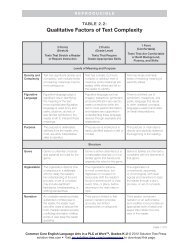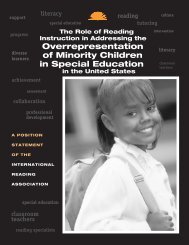Dorothy Strickland - International Reading Association
Dorothy Strickland - International Reading Association
Dorothy Strickland - International Reading Association
Create successful ePaper yourself
Turn your PDF publications into a flip-book with our unique Google optimized e-Paper software.
Snow, Burns, and Griffin (1998) describe low SES as both an individual risk factor and a group<br />
risk factor. A low-status child in a generally moderate or upper-status school or community is far<br />
less at risk than that same child in a whole school or community of low-status children (p. 124).<br />
School funding plays an important role in the socioeconomic status of schools and<br />
communities. Recent studies have reanalyzed the research on school funding and its influence on<br />
the SES of schools and school districts. Biddle and Berliner (2003) analyzed the average annual<br />
expenditures per student for each of the United States and the variation among districts in total<br />
revenues per student within each state. They found that while the disparities in funding differ<br />
sharply among the states, they were greater within some states than among the states as a group.<br />
Unlike the Coleman Report (1972), which reported that school quality (and level of school<br />
funding) had little-to-no impact once home and peer factors were taken into account, Biddle and<br />
Berliner state that funding inequities do make a difference (p. 8).<br />
Home Environment<br />
Even before children enter kindergarten, the achievement gap is in place. The U.S. Department<br />
of Education’s Early Childhood Longitudinal Study (ECLS-K; 2000) shows that by the time<br />
children are five years old, there is a gap in school-related skills and knowledge between African<br />
American and European American children, even when their mothers have equal years of<br />
schooling (it is important to keep in mind that the quality of the mothers’ schooling is not<br />
factored into these measures). Phillips (2000) analyzed several gap-related surveys in an attempt<br />
to describe age-related changes in the Black-White gap as children move through the grades:<br />
Taken together, we estimate that at least half of the black-white gap that exists at the end of<br />
twelfth grade can be attributed to the gap that already existed at the beginning of first grade. The<br />
remainder of the gap seems to emerge during the school years. (p. 136)<br />
Although little is known about the child-rearing practices that may affect children’s<br />
school performance during the upper elementary years and beyond, it may be safe to say that<br />
differences (not deficits) in child-rearing practices may contribute to the gap. Explanations such<br />
as that offered by Ogbu (2002) attribute much of the problem to Black youth cultural patterns<br />
and behaviors that are counterproductive for academic success. Other researchers dispute this<br />
conclusion. Ferguson (2002) speculates that what Ogbu observed was “a clumsy attempt by<br />
black students to search for a comfortable racial identity.” Indeed, as preadolescent and<br />
adolescent students attempt to find their place in society, their personal goals and behaviors often<br />
diverge from what the school expects and demands. When these students come from cultural<br />
backgrounds that differ greatly from that of the school, their attempts to “find their place” may<br />
put them at risk of missing out on important educational experiences offered by schools and<br />
society.<br />
Linguistic Background<br />
The low achievement of poor African American and Hispanic children has often been associated<br />
with their dialect or language. During the 1960s, linguists looked closely at language diversity as<br />
a cause of school failure. Those studies revealed key principles of language learning that remain<br />
helpful to teachers and curriculum developers: All language varieties are equally valid; all<br />
language varieties can accommodate all levels of thought; and any variety of standard English is<br />
not intrinsically better than any nonstandard dialect (Gopaul-McNicol, Reid, & Wisdom, 1998,<br />
p. 7). Similarly, research in the language development of children for whom English is a second<br />
Copyright © 2005, 2010 by <strong>Dorothy</strong> S. <strong>Strickland</strong> 2
















